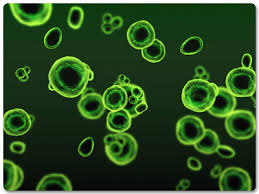
 Following global fears of an uncontrollable population boom, during the late 1940s and the early 1950s Chlorella was seen as a new and promising primary food source and as a possible solution to the then-current world hunger crisis. Many people during this time thought hunger would be an overwhelming problem and saw Chlorella as a way to end this crisis by providing large amounts of high-quality food for a relatively low cost
Following global fears of an uncontrollable population boom, during the late 1940s and the early 1950s Chlorella was seen as a new and promising primary food source and as a possible solution to the then-current world hunger crisis. Many people during this time thought hunger would be an overwhelming problem and saw Chlorella as a way to end this crisis by providing large amounts of high-quality food for a relatively low cost
Many institutions began to research the algae, including the Carnegie Institution, the Rockefeller Foundation, the NIH, UC Berkeley, the Atomic Energy Commission, and Stanford University. Following World War II, many Europeans were starving and many Malthusians attributed this not only to the war, but to the inability of the world to produce enough food to support the currently increasing population. According to a 1946 FAO report, the world would need to produce 25 to 35 percent more food in 1960 than in 1939 to keep up with the increasing population, while health improvements would require a 90 to 100 percent increase.[3] Because meat was costly and energy-intensive to produce, protein shortages were also an issue. Increasing cultivated area alone would go only so far in providing adequate nutrition to the population. The USDA calculated that, to feed the U.S. population by 1975, it would have to add 200 million acres (800,000 km2) of land, but only 45 million were available. One way to combat national food shortages was to increase the land available for farmers, yet the American frontier and farm land had long since been extinguished in trade for expansion and urban life. Hopes rested solely on new agricultural techniques and technologies. Because of these circumstances, an alternative solution was needed.
To cope with the upcoming post-war population boom in the United States and elsewhere, researchers decided to tap into the unexploited sea resources. Initial testing by the Stanford Research Institute showed Chlorella (when growing in warm, sunny, shallow conditions) could convert 20 percent of solar energy into a plant that, when dried, contains 50 percent protein.[3] In addition, Chlorella contains fat and vitamins. The plant's photosynthetic efficiency allows it to yield more protein per unit area than any other plant-one scientist predicted 10,000 tons of protein a year could be produced with just 20 workers staffing a one-thousand-acre (4-square kilometer) Chlorella farm.[3] The pilot research performed at Stanford and elsewhere led to immense press from journalists and newspapers, yet did not lead to large-scale algae production. Chlorella seemed like a viable option because of the technological advances in agriculture at the time and the widespread acclaim it got from experts and scientists who studied it. Algae researchers had even hoped to add a neutralized Chlorella powder to conventional food products, as a way to fortify them with vitamins and minerals.[3]
When the preliminary laboratory results were published, the reaction of scientific literature backed the possibilities of the supposed superfood. Science News Letter praised the optimistic results in an article entitled "Algae to Feed the Starving." John Burlew, the editor of the Carnegie Institution of Washington book Algal Culture-from Laboratory to Pilot Plant, stated, "the algae culture may fill a very real need,"[7] which Science News Letter turned into "future populations of the world will be kept from starving by the production of improved or educated algae related to the green scum on ponds." The cover of the magazine also featured Arthur D. Little's Cambridge laboratory, which was a supposed future food factory. A few years later, the magazine published an article entitled "Tomorrow's Dinner", which stated, "There is no doubt in the mind of scientists that the farms of the future will actually be factories." Science Digest also reported, "common pond scum would soon become the world's most important agricultural crop." At least in the decades that followed, algae was not cultivated on nearly that scale, however.
